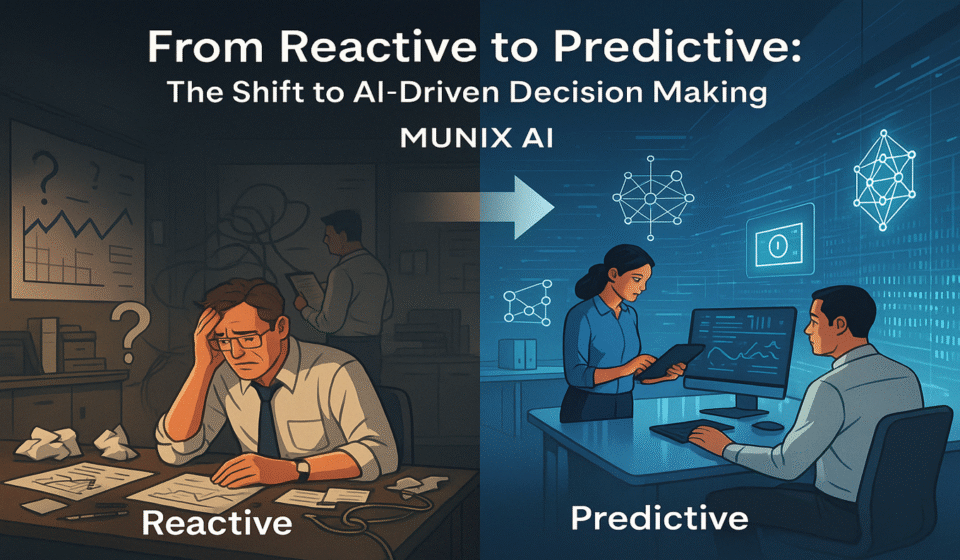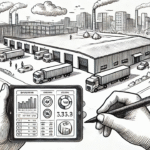
From Reactive to Predictive: The Shift to AI-Driven Decision Making
Why Leading Companies Are Rewiring Their Supply Chains with AI
In today’s global markets, volatility is the norm — not the exception.
Supply disruptions, demand swings, geopolitical instability, and rising customer expectations are putting unprecedented pressure on supply chains. For many companies, the response remains reactive: firefighting after problems arise, scrambling to recover from disruptions, and absorbing the cost of inefficiency.
But there’s a new playbook emerging — one that replaces reaction with prediction, guesswork with data-driven foresight, and manual intervention with automated, optimized decisions.
At the heart of this transformation is AI-powered supply chain analytics — a shift that’s not just operational but strategic.
The Cost of Staying Reactive
Reactive decision-making exposes companies to:
- Lost revenue from stockouts and missed sales
- Working capital inefficiencies from excess inventory
- Rising logistics costs due to last-minute rerouting and expedited shipments
- Supplier failures that go undetected until it’s too late
- Missed sustainability targets because issues are discovered after the damage is done
For C-level executives, this translates into margin erosion, risk exposure, and customer dissatisfaction. For board members and investors, it means fragile operations vulnerable to shocks.
Predictive Analytics: Turning Data into Competitive Advantage
AI-driven analytics enables organizations to shift from hindsight to foresight. By leveraging machine learning models trained on historical data, real-time signals, and external factors (like weather, market conditions, and geopolitical events), companies can:
- Anticipate disruptions before they happen
- Adapt proactively instead of reacting reactively
- Automate smarter decisions at scale
The result? More resilient, agile, and efficient operations — directly contributing to profitability and shareholder value.
Where Predictive AI Creates Business Impact
✅ Smarter Demand Planning
- Predict demand fluctuations at the SKU level.
- Factor in seasonality, promotions, and external variables.
- Align production and procurement plans to actual market needs.
✅ Inventory Efficiency
- Reduce working capital without risking stockouts.
- Optimize safety stock dynamically based on real-time risk signals.
- Free up cash for strategic initiatives.
✅ Supplier Risk Mitigation
- Monitor supplier performance proactively.
- Detect early warning signs of delays or quality issues.
- Diversify and de-risk sourcing strategies before disruption hits.
✅ Logistics Optimization
- Predict delivery delays and optimize routing in real time.
- Minimize expedited freight costs.
- Improve service levels and customer satisfaction.
Why Investors and Boards Are Paying Attention
In a world where operational excellence directly influences company valuation, predictive supply chain capabilities are becoming a mark of future-ready leadership. Investors recognize that companies with data-driven resilience:
- Recover faster from disruptions.
- Preserve customer trust.
- Manage working capital more efficiently.
- Meet ESG goals with credible, trackable progress.
Simply put: Predictive, AI-enabled supply chains aren’t just a technical upgrade — they are a business model advantage.
The Prescriptive Edge: From Prediction to Action
Leading solutions go beyond forecasting problems. They recommend the next best action:
- How much to reorder — and when.
- Which suppliers or transport routes to prioritize.
- Where to rebalance inventory across the network.
This is where AI moves from insight to impact — not just highlighting risks, but driving better decisions automatically.
How to Get Started: A Leadership Approach to Predictive Transformation
- Prioritize high-impact areas: Focus on where volatility hurts most — demand planning, inventory, supplier risk, or logistics.
- Build the right data foundation: Integrated, clean data across functions is key to effective AI.
- Start small, scale fast: Pilot predictive models on one segment or product line. Prove value. Expand.
- Align leadership and culture: Predictive decision-making is as much about mindset as it is about technology.
The Leadership Mandate: From Reactive to Resilient
The question is no longer if predictive supply chains will become the standard — but when.
For CEOs, CFOs, COOs, CSCOs, and manufacturing leaders, the opportunity is clear: proactively manage risk, optimize working capital, and unlock strategic agility. For investors and board members, it signals forward-thinking governance and operational excellence.
The shift from reactive to predictive decision-making is not just about technology. It’s about building a supply chain — and an organization — that’s ready for whatever comes next.
Interested in exploring what predictive supply chain analytics could look like for your business? Let’s talk.






